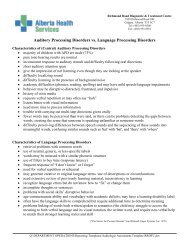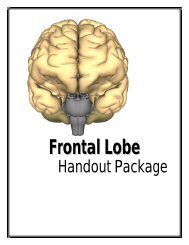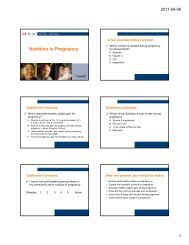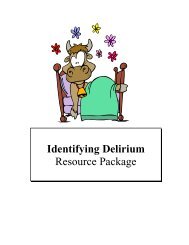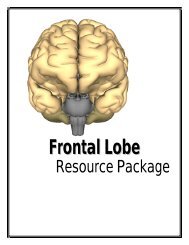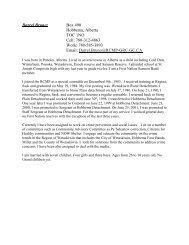Dialectical Behaviour Therapy (DBT) for Borderline ... - Onehealth.ca
Dialectical Behaviour Therapy (DBT) for Borderline ... - Onehealth.ca
Dialectical Behaviour Therapy (DBT) for Borderline ... - Onehealth.ca
Create successful ePaper yourself
Turn your PDF publications into a flip-book with our unique Google optimized e-Paper software.
<strong>Dialecti<strong>ca</strong>l</strong> <strong>Behaviour</strong><br />
<strong>Therapy</strong> (<strong>DBT</strong>) <strong>for</strong><br />
<strong>Borderline</strong> Personality<br />
Disorder<br />
Dr. Kathy Fitch, Psychiatrist<br />
Janice Wingrave, , RPN, Clini<strong>ca</strong>l Supervisor<br />
Janice Wingrave, , RPN<br />
‣ Clini<strong>ca</strong>l supervisor to comprehensive <strong>DBT</strong><br />
outpatient program with 9 therapists, 2<br />
psychiatrists, and allied supports (OT, ILS),<br />
CCMHC<br />
‣ Maintaining our program’s s participation in<br />
ongoing <strong>for</strong>mal training and research with BTech<br />
‣ Organizing edu<strong>ca</strong>tional opportunities <strong>for</strong><br />
clinicians outside the clinic<br />
‣ <strong>DBT</strong> Intensive Training (BTech(<br />
BTech), Parts 1 & 2,<br />
and ongoing BTech supervision<br />
Dr. Kathy Fitch<br />
‣ Psychiatrist in <strong>DBT</strong> program (25% of time),<br />
CCMHC<br />
‣ Psychiatrist on general adult psychiatry inpatient<br />
unit, Foothills Medi<strong>ca</strong>l Centre (75% of time)<br />
‣ Involved in training and supervision of medi<strong>ca</strong>l<br />
students and residents<br />
‣ <strong>DBT</strong> Fellowship, <strong>DBT</strong> Foundational Training<br />
(BTech), Beck Institute CBT External Fellowship<br />
1
“Standard” <strong>DBT</strong> Program<br />
‣ <strong>DBT</strong> individual therapy (weekly)<br />
‣ <strong>DBT</strong> skills group (weekly when in group)<br />
‣ <strong>DBT</strong> consult group (therapists only)<br />
‣ Telephone coaching (ideally 24/7)<br />
‣ 12 month commitment<br />
‣ +/- <strong>DBT</strong> generalization group (approaching<br />
graduation)<br />
‣ +/- <strong>DBT</strong> family edu<strong>ca</strong>tion series<br />
<strong>DBT</strong> Skills Group<br />
‣ 4 Skills Training Modules:<br />
• Mindfulness skills<br />
• Emotion Regulation skills<br />
• Distress Tolerance skills<br />
• Interpersonal Effectiveness skills<br />
What is <strong>Borderline</strong> Personality<br />
Disorder<br />
(DSM-IV<br />
IV-TR definition)<br />
A pervasive pattern of instability of<br />
interpersonal relationships, self-<br />
image, and affects, and marked<br />
impulsivity beginning by early<br />
adulthood and present in a variety of<br />
contexts, as indi<strong>ca</strong>ted by 5 (or more)<br />
of the following:<br />
2
What is BPD<br />
1. Frantic ef<strong>for</strong>ts to avoid real or imagined<br />
abandonment. *Not (5)<br />
2. Pattern of unstable and intense<br />
interpersonal relationships characterized by<br />
alternating between extremes of idealization<br />
and devaluation.<br />
3. Identity disturbance: markedly and<br />
persistently unstable self-image or sense of<br />
self.<br />
What is BPD<br />
4. Impulsivity in at least two areas that are<br />
potentially self-damaging (e.g., spending,<br />
sex, substance abuse, reckless driving,<br />
binge eating). *Not (5)<br />
5. Recurrent suicidal behaviour, , gestures, or<br />
threats, or self-mutilating<br />
behaviour.<br />
6. Affective instability due to a marked<br />
reactivity of mood (e.g., intense episodic<br />
dysphoria, , irritability, or anxiety usually<br />
lasting a few hours and only hours and only<br />
rarely more than a few days).<br />
What is BPD<br />
7. Chronic feelings of emptiness.<br />
8. Inappropriate, intense anger or difficulty<br />
controlling anger (e.g., frequent displays of<br />
temper, constant anger, recurrent physi<strong>ca</strong>l<br />
fights).<br />
9. Transient, stress-related related paranoid ideation<br />
or severe dissociative symptoms.<br />
3
Objectives<br />
1. Gain an understanding of the Biosocial<br />
Theory of <strong>Borderline</strong> Personality<br />
Disorder<br />
2. Gain an understanding of the key<br />
components of a <strong>DBT</strong> approach: Core<br />
Strategies and <strong>Dialecti<strong>ca</strong>l</strong> Assumptions<br />
3. Leave the session with one clear<br />
strategy that <strong>ca</strong>n be used with a client<br />
and/or loved one<br />
Objectives<br />
1. Gain an understanding of the<br />
Biosocial Theory of <strong>Borderline</strong><br />
Personality Disorder<br />
4
Bio-Social Theory<br />
EMOTION DYSREGULATION<br />
Emotionally<br />
Vulnerable<br />
individual<br />
Invalidating<br />
Environment<br />
Linehan 1993<br />
‣ Communi<strong>ca</strong>tion <strong>ca</strong>n be verbal or non-<br />
verbal, and often it is both.<br />
What is an invalidating<br />
environment<br />
‣ Core features:<br />
• Indiscriminately rejects communi<strong>ca</strong>tion of<br />
private experiences and self-initiated<br />
behaviours<br />
• Intermittently rein<strong>for</strong>ces es<strong>ca</strong>lation of<br />
emotional responses and display<br />
• Oversimplifies ease of problem solving and<br />
meeting goals<br />
5
What is an invalidating<br />
environment<br />
‣ The private experience of an individual is<br />
negated by the environment<br />
• E.g. You don’t t really think that.<br />
• E.g. You’re doing that on purpose. I didn’t t even<br />
mean it that way.<br />
• E.g. That’s s not how you really feel.<br />
• Eg. . You’re being stupid/ridiculous/silly.<br />
• E.g. You’re not really hurt.<br />
What is an invalidating<br />
environment<br />
‣ The private experience of an individual<br />
isn’t t accurately recognized or reflected by<br />
the environment<br />
• E.g. emotionally sensitive child with a<br />
busy/preoccupied parent<br />
Internalized invalidating<br />
environment<br />
‣ Stop trusting your own emotions.<br />
‣ Stop trusting your own perspective.<br />
‣ Tendency to judge yourself and others.<br />
‣ Lack of skills in managing your<br />
thoughts/feelings/behaviours<br />
behaviours.<br />
6
Objectives<br />
1. Gain an understanding of the Biosocial<br />
Theory of <strong>Borderline</strong> Personality<br />
Disorder<br />
2. Gain an understanding of the key<br />
components of a <strong>DBT</strong> approach: Core<br />
Strategies and <strong>Dialecti<strong>ca</strong>l</strong><br />
Assumptions<br />
<strong>DBT</strong> Core Strategies<br />
Acceptance/validation<br />
Change<br />
7
Successful Validation: Reduces<br />
arousal<br />
‣ Validation has succeeded when arousal<br />
associated with invalidation is reduced<br />
Highly aroused<br />
Ready to learn<br />
Too relaxed<br />
What to validate<br />
“ Validation does not automati<strong>ca</strong>lly imply<br />
liking, approval or preference”<br />
MM Linehan 1997<br />
What to validate<br />
‣ Recognizing the kernel of truth in the<br />
person’s s experience.<br />
‣ Remember: emotions are one of the<br />
easiest things to validate<br />
• E.g. You seem really hurt/mad/affected by that.<br />
8
Remember!<br />
‣ Match the verbal and nonverbal message<br />
‣ NB: If the tone of voice is mismatched,<br />
then words intended to “validate” the<br />
person’s s feelings may be experienced as<br />
invalidating<br />
• E.g. (irritable instead of concerned) “You<br />
seem really angry about that.”<br />
• E.g. (cheerful instead of concerned) “You<br />
seem really sad.”<br />
Challenges of validating the<br />
sensitive individual<br />
‣ Quicker reaction to events than expected<br />
‣ Higher than expected intensity of reactions<br />
‣ Slower settling of emotions<br />
9
Mindfulness<br />
‣ “The repetitive act of directing your attention to<br />
only one thing in this one moment” means<br />
training your mind to pay attention to what you<br />
choose to pay attention to instead of letting your<br />
mind hijack you.<br />
‣ Whatever your attention is on, that’s s what life is<br />
<strong>for</strong> you at any given moment.<br />
‣ Considered the core skill required to develop<br />
other <strong>DBT</strong> skills.<br />
‣ Metaphors:<br />
• Untrained puppy<br />
• TV channel surfing<br />
• Clouds in the sky<br />
Mindfulness<br />
10
Change strategies<br />
‣ Based on thought/emotion/behaviour<br />
change techniques used throughout<br />
cognitive-behaviour<br />
therapy (CBT)<br />
‣ Strong emphasis on validation to balance<br />
the strain of change<br />
‣ Mindfulness skills allow <strong>for</strong> clear<br />
observation, and contemplation of<br />
alternatives <strong>for</strong> change<br />
11
<strong>DBT</strong> Assumptions about Patients<br />
‣ Patients are doing the best they <strong>ca</strong>n<br />
‣ Patients want to improve<br />
‣ The lives of suicidal BPD patients are unbearable as<br />
they are being currently lived<br />
‣ Patients must learn new behaviours in all relevant<br />
contexts<br />
‣ Patients <strong>ca</strong>nnot fail in <strong>DBT</strong><br />
‣ Patients did not <strong>ca</strong>use all their own problems, but<br />
they are responsible <strong>for</strong> solving them<br />
‣ Patients need to do better, try harder and/or be<br />
more motivated to change<br />
Dialectics<br />
‣ A dialectic is finding synthesis in opposing<br />
experiences and points of view<br />
‣ “Dialectics” involves several assumptions about<br />
the nature of reality: 1) everything is connected<br />
to everything else; 2) change is constant and<br />
inevitable; and 3) opposites <strong>ca</strong>n be integrated to<br />
<strong>for</strong>m a closer approximation to the truth (which is<br />
always evolving).<br />
‣ Nothing is just black and white.<br />
Dialectic: an example<br />
‣ 2 people standing on opposite ends of an<br />
elephant will offer very different<br />
descriptions of what an elephant looks like<br />
‣ The “synthesis” of these descriptions<br />
incorporates both points of view<br />
12
Objectives<br />
1. Gain an understanding of the Biosocial<br />
Theory of <strong>Borderline</strong> Personality<br />
Disorder<br />
2. Gain an understanding of the key<br />
components of a <strong>DBT</strong> approach: Core<br />
Strategies and <strong>Dialecti<strong>ca</strong>l</strong> Assumptions<br />
3. Leave the session with one clear<br />
strategy that <strong>ca</strong>n be used with a client<br />
and/or loved one<br />
What strategy will you<br />
take away from today’s<br />
session<br />
13
Summary<br />
1. Gain an understanding of the Biosocial<br />
Theory of <strong>Borderline</strong> Personality<br />
Disorder<br />
2. Gain an understanding of the key<br />
components of a <strong>DBT</strong> approach: Core<br />
Strategies and <strong>Dialecti<strong>ca</strong>l</strong> Assumptions<br />
3. Leave the session with one clear<br />
strategy that <strong>ca</strong>n be used with a client<br />
and/or loved one<br />
Contact In<strong>for</strong>mation<br />
‣ Referrals: Access Mental Health (943-<br />
1500), private clinic Inner Solutions<br />
‣ Website in<strong>for</strong>mation: behavioraltech.org,<br />
borderlinepersonalitytoday.com,<br />
bpdcentral.com<br />
‣ Staff recruitment: CHR website<br />
‣ For more in<strong>for</strong>mation:<br />
• <strong>DBT</strong> Clinic phone number: 297-7311<br />
7311<br />
2006 CHR People First Awards: <strong>Dialecti<strong>ca</strong>l</strong><br />
<strong>Behaviour</strong> <strong>Therapy</strong> Treatment Team<br />
14
Community Edu<strong>ca</strong>tion Service<br />
To register <strong>for</strong> notifi<strong>ca</strong>tion or an upcoming<br />
edu<strong>ca</strong>tion session go to:<br />
www.fcrc.sacyhn.<strong>ca</strong><br />
For general CES enquiries Email:<br />
ces@sacyhn.<strong>ca</strong><br />
Call: 403-955<br />
955-7420<br />
Funding generously provided by En<strong>ca</strong>na<br />
Corporation and the Alberta Children’s<br />
Hospital Foundation<br />
15





